SLVSBG0E August 2012 – April 2016 TPD4E101
PRODUCTION DATA.
- 1 Features
- 2 Applications
- 3 Description
- 4 Revision History
- 5 Pin Configuration and Functions
- 6 Specifications
- 7 Detailed Description
- 8 Application and Implementation
- 9 Power Supply Recommendations
- 10Layout
- 11Device and Documentation Support
- 12Mechanical, Packaging, and Orderable Information
Package Options
Mechanical Data (Package|Pins)
- DPW|4
Thermal pad, mechanical data (Package|Pins)
- DPW|4
Orderable Information
6 Specifications
6.1 Absolute Maximum Ratings
over operating free-air temperature range (unless otherwise noted)| MIN | MAX | UNIT | |
|---|---|---|---|
| Peak Pulse Current (tp = 8/20 µs) | 3 | A | |
| Peak Pulse Power ( tp = 8/20 µs) | 40 | W | |
| Operating temperature | –40 | 125 | ºC |
| Storage temperature, Tstg | –65 | 155 | ºC |
6.2 ESD Ratings
| VALUE | UNIT | |||
|---|---|---|---|---|
| V(ESD) | Electrostatic discharge | Human body model (HBM), per ANSI/ESDA/JEDEC JS-001(1) | ±2500 | V |
| Charged device model (CDM), per JEDEC specification JESD22-C101(2) | ±1000 | |||
| IEC 61000-4-2 Contact Discharge | ±15000 | |||
| IEC 61000-4-2 Air-gap Discharge | ±15000 | |||
(1) JEDEC document JEP155 states that 500-V HBM allows safe manufacturing with a standard ESD control process.
(2) JEDEC document JEP157 states that 250-V CDM allows safe manufacturing with a standard ESD control process.
6.3 Recommended Operating Conditions
over operating free-air temperature range (unless otherwise noted)| MIN | MAX | UNIT | ||
|---|---|---|---|---|
| Operating Free-Air Temperature, TA | –40 | 125 | °C | |
| Operating Voltage | Pin 1,2,3,4 to GND | –5.5 | 5.5 | V |
6.4 Thermal Information
| THERMAL METRIC(1) | TPD4E101 | UNIT | |
|---|---|---|---|
| DPW (X2SON) | |||
| 4 PINS | |||
| RθJA | Junction-to-ambient thermal resistance | 291.8 | °C/W |
| RθJC(top) | Junction-to-case (top) thermal resistance | 224.2 | °C/W |
| RθJB | Junction-to-board thermal resistance | 245.8 | °C/W |
| ψJT | Junction-to-top characterization parameter | 31.4 | °C/W |
| ψJB | Junction-to-board characterization parameter | 245.6 | °C/W |
| RθJC(bot) | Junction-to-case (bottom) thermal resistance | 195.4 | °C/W |
(1) For more information about traditional and new thermal metrics, see the Semiconductor and IC Package Thermal Metrics application report, SPRA953.
6.5 Electrical Characteristics
TA = –40°C to +125°C (unless otherwise specified)| PARAMETER | TEST CONDITIONS | MIN | TYP | MAX | UNIT | |
|---|---|---|---|---|---|---|
| VRWM | Reverse stand-off voltage | ±5.5 | V | |||
| ILEAK | Leakage current | Pins = 5 V, GND = 0 V | 100 | nA | ||
| VClamp1,2 | Clamp voltage from data pin to ground pin | IPP = 1 A, 8/20 μs(1) | 10 | V | ||
| IPP = 3 A, 8/20 μs(1) | 13 | V | ||||
| VClamp2,1 | Clamp voltage from ground pin to data pin | IPP = 1 A, 8/20 μs(1) | 9 | V | ||
| IPP = 3 A, 8/20 μs(1) | 13 | V | ||||
| RDYN | Dynamic resistance | Pins to GND(2) | 0.45 | Ω | ||
| GND to Pins(2) | 0.42 | Ω | ||||
| CIO | I/O Capacitance | VIO = 2.5 V | 4.8 | 7 | pF | |
| VBRF | Break-down voltage, pin 1, 2, 3, or 4 to GND | IIO = 1 mA | 6 | V | ||
| VBRR | Break-down voltage, GND to pin 1, 2, 3, or 4 | IIO = 1 mA | 6 | V | ||
(1) Non-repetitive current pulse 8/20 µs exponentially decaying waveform according to IEC61000-4-5.
(2) Extraction of RDYN using least squares fit of TLP characteristics between I = 10 A and I = 20 A.
6.6 Typical Characteristics
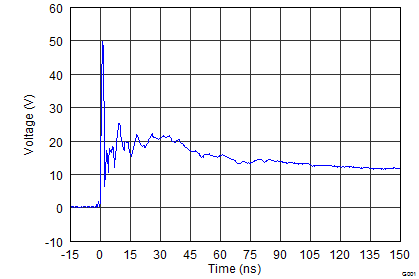 Figure 1. IEC 61000-4-2 Clamping Voltage, 8-kV Contact
Figure 1. IEC 61000-4-2 Clamping Voltage, 8-kV Contact
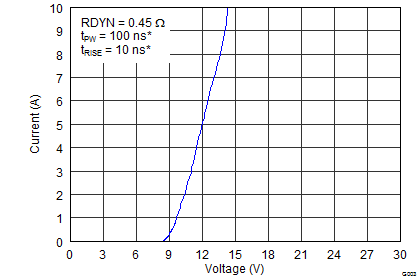 Figure 3. TLP, tPW = 100 nS, tRISE = 10 nS, Data to GND
Figure 3. TLP, tPW = 100 nS, tRISE = 10 nS, Data to GND
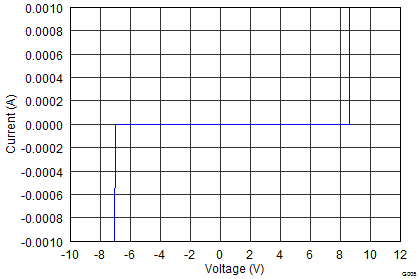 Figure 5. IV Curve
Figure 5. IV Curve
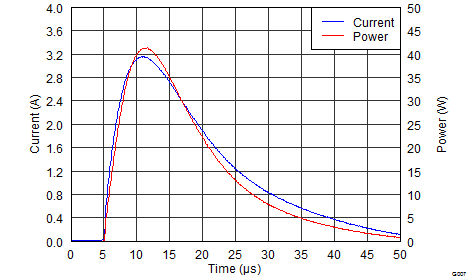 Figure 7. Surge Curves, GND to Data
Figure 7. Surge Curves, GND to Data
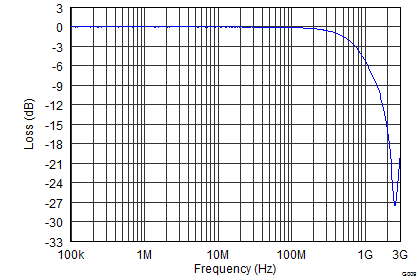 Figure 9. Insertion Loss
Figure 9. Insertion Loss
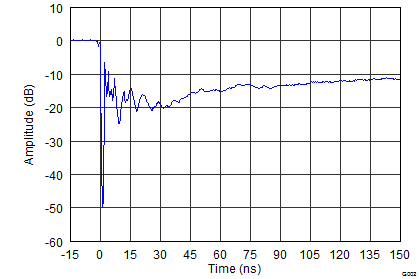 Figure 2. IEC 61000-4-2 Clamping Voltage, –8-kV Contact
Figure 2. IEC 61000-4-2 Clamping Voltage, –8-kV Contact
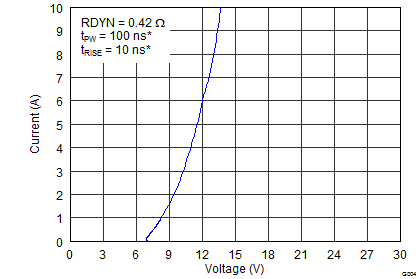 Figure 4. TLP, tPW = 100 nS, tRISE = 10 nS, GND to Data
Figure 4. TLP, tPW = 100 nS, tRISE = 10 nS, GND to Data
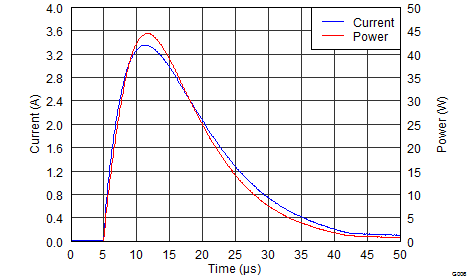 Figure 6. Surge Curves, Data to GND
Figure 6. Surge Curves, Data to GND
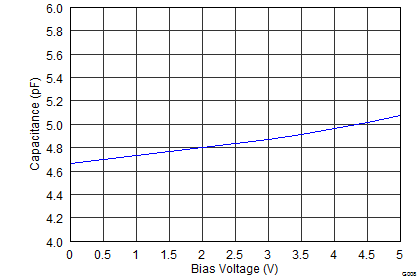 Figure 8. Capacitance
Figure 8. Capacitance